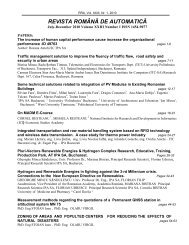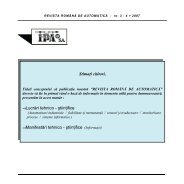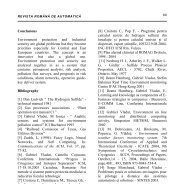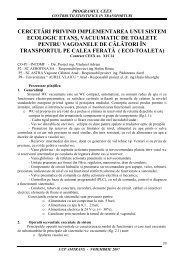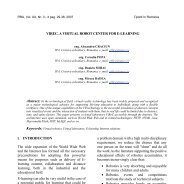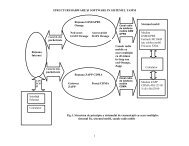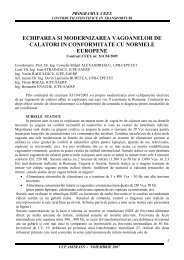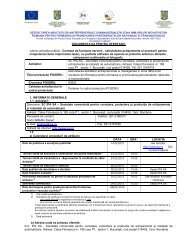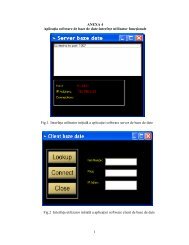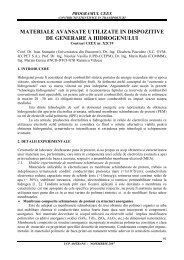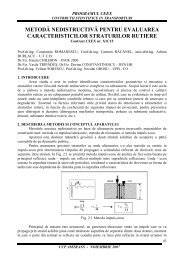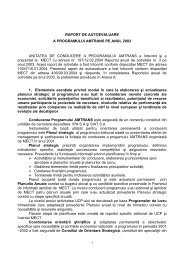REVISTA ROMÃNÄ DE AUTOMATICÄ - IPA SA
REVISTA ROMÃNÄ DE AUTOMATICÄ - IPA SA
REVISTA ROMÃNÄ DE AUTOMATICÄ - IPA SA
Create successful ePaper yourself
Turn your PDF publications into a flip-book with our unique Google optimized e-Paper software.
<strong>REVISTA</strong> ROMÂNĂ <strong>DE</strong> AUTOMATICĂ<br />
37<br />
5. Conclusions<br />
The quality analysis and tombstoning<br />
appearances situations demonstrated that the<br />
type 2 and 3 apertures assure solder paste on<br />
pads in excess. As upshot the wetting angle<br />
of solder joints are close to 90°, the limit of<br />
quality acceptance. Also, the solder paste in<br />
excess offers condition for spread solder balls<br />
on pcb surface. The theoretical analysis and<br />
practical results show the importance of<br />
solder paste deposit’s axial dimension<br />
compared to chip component axial dimension<br />
as a tombstoning factor.<br />
Based on the practical results of experiments,<br />
the generally accepted criteria for a chip,<br />
component solder adequacy, the joint should<br />
extend up the component termination for a<br />
minimum of one-third of the component<br />
height, or 0.4 mm, whichever is less, the<br />
tolerance of chip components cases, the<br />
variability of pad dimensions, the authors are<br />
proposing the following requirements for<br />
stencil design regarding chip components<br />
assembling in vapour phase technology:<br />
radial apertures dimension, Xa :<br />
Xa = W+H (4)<br />
axial apertures dimension, Ya :<br />
Cp – Ya = S, Cp + Ya = L=T, Ya = (L+T) /<br />
2 (5)<br />
stencil thickness: 0.125mm<br />
As a result, the team defined the necessary<br />
criteria in order to obtain optimum thermal<br />
profile by measuring temperatures directly on<br />
pcb surface: preheating with 1.4 °C/s until<br />
185-190°C and go to range of melting point<br />
with 0.66 °C/s until maximum temperature<br />
230 °C.<br />
References<br />
[1] T. C. Cucu, N.D.Codreanu, I. Plotog,<br />
"Reflow process using lead free materialsbasics<br />
and comparison with tin-lead process",<br />
Proceedings of the 2005 Interntional<br />
Symposium for Design Technology and<br />
Electronics Packaging (SIITME 2005), Cluj-<br />
Napoca, Romania, September 22-25, 2005,<br />
pp. 250 - 255.<br />
[2] I. Plotog, S. Jianu, C. Turcu, T. C. Cucu,<br />
N.D.Codreanu, “Multi-criterial Approach for<br />
Implementing of Lead-free Technology”, 4th<br />
European Microelectronics and Packaging<br />
Symposium, May 21-24, Terme Catez,<br />
Slovenia, pp. 301-306.<br />
[3] I Plotog, S. Jianu, C. Turcu, A. Stan,<br />
T.C.Cucu, N.D.Codreanu, DFM Concept for<br />
Wave Soldering Technology, SIITME 2006,<br />
Iasi, September 2006 Romania<br />
[4] Klein Wassink, Soldering in Electronics<br />
(2nd Edition), Electrochemical Publications,<br />
Port Erin, Isle of Man, Great Britain, 1989<br />
[5] S. Jianu, I. Plotog, C.Turcu, A. Stan,<br />
T.C.Cucu, N.D.Codreanu, Reliability Aspects<br />
for optimal Implementation of Lead-free<br />
Technology, SIITME 2006, Iasi, September<br />
2006 Romania<br />
[6] ***, Internet web sites related to<br />
DFM topics.<br />
[7] ***, www.ipc.org<br />
AR4-7.doc



